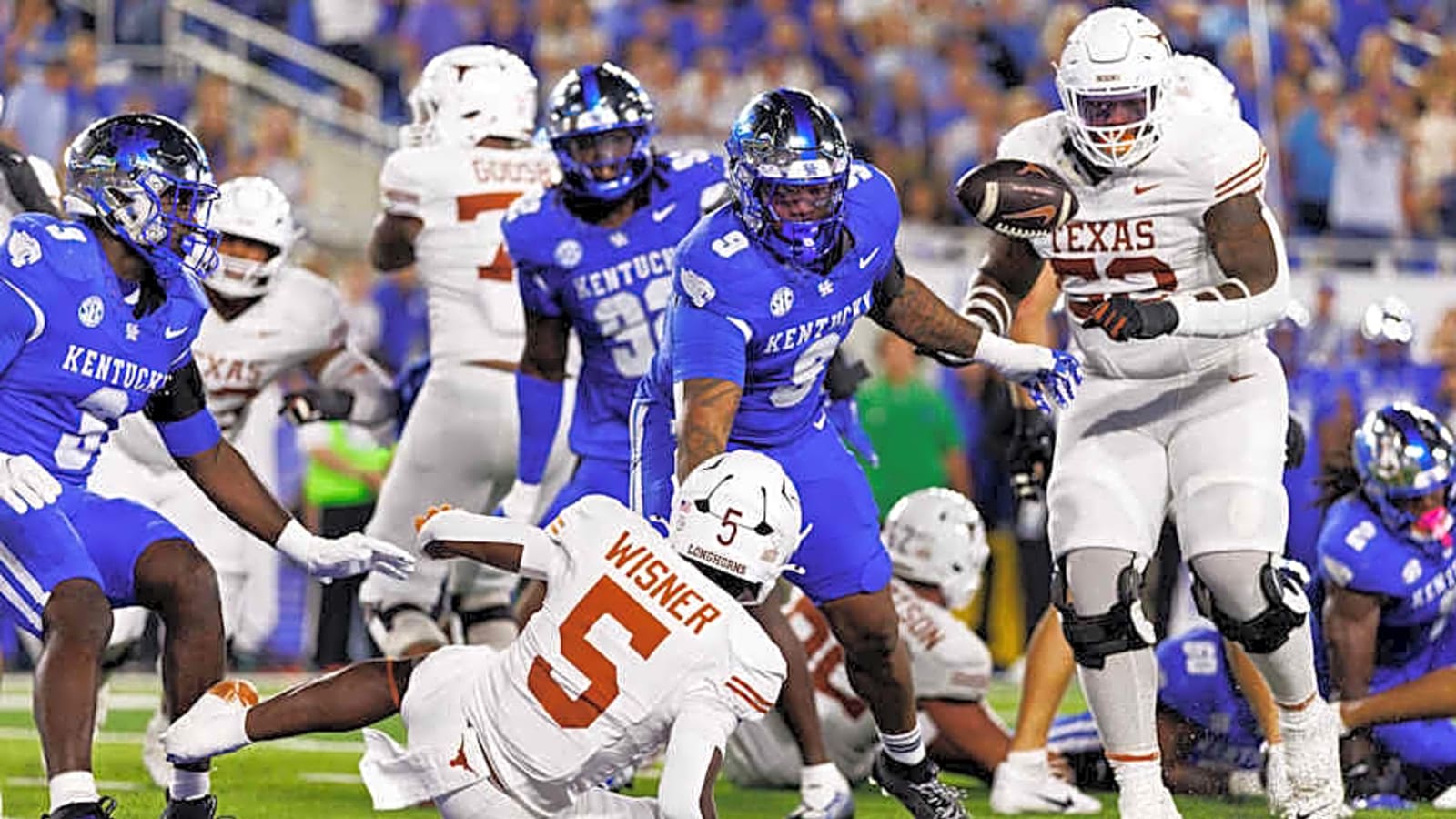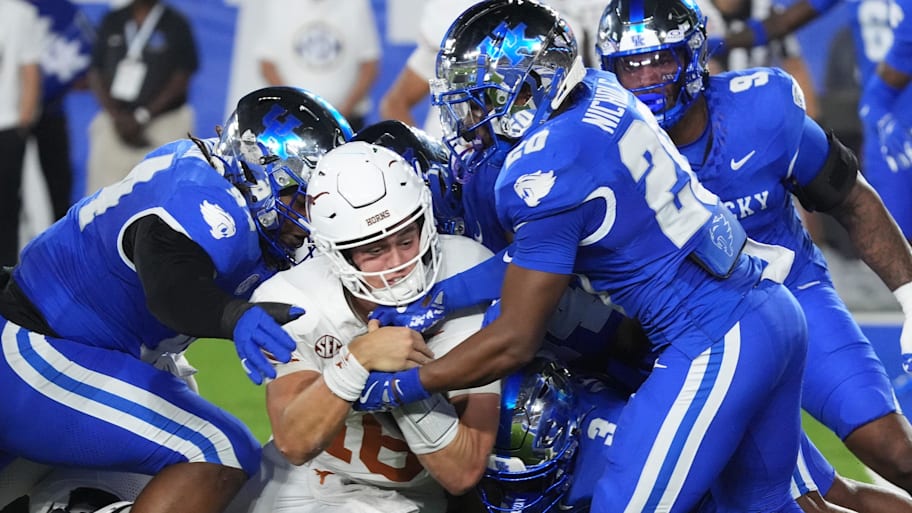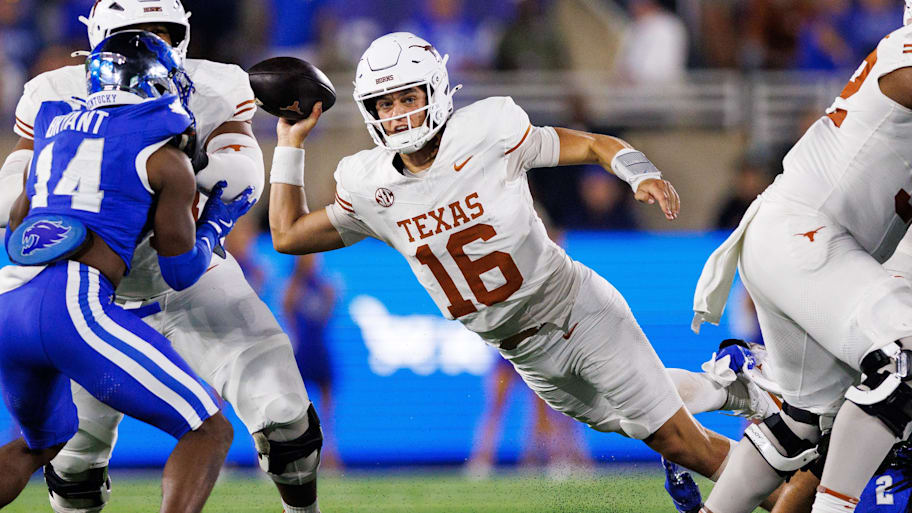
After the Texas Longhorns' underwhelming offensive performance in Lexington against the Kentucky Wildcats, Brooks Austin of The Film Guy Network recorded a film review to determine the "why" behind Texas' miscues.
Austin gave Kentucky credit in creating the Longhorns' struggles, explaining that he has seen superior opponents enter Kroger Field many times and struggle.
"Kentucky played great. They do this to people," he said.
But the root of Texas's offensive instability goes further than who they play. There have been constant themes that have contributed to weak showings. With that in mind, here are the main takeaways about head coach and playcaller Steve Sarkisian's offense from Austin's hour-long video.
The Offensive Line

After what he saw against Kentucky, Austin foresees the rest of Texas's opponents bringing the heat to the Longhorns defensively, pressuring quarterback Arch Manning and forcing the offensive line into decision-making while urging Manning to connect with pass-catchers in man-to-man coverage. Manning and his pass-catchers have not shown consistent capability to do so impressively thus far.
With the offensive line, Austin saw the Longhorns' front failing to work effectively as a balanced unit, left guard Nick Brooks was exposed the most out of the bunch.
"It got to a point where they were just picking on the left guard in pass protection," Austin said.
Austin explained that Brooks seemed to be giving up his tendencies with his eyes, and the Longhorns' line as a whole became overwhelmed by the "exotic" blitz numbers and concepts Kentucky was bringing at them.
There were times when Manning didn't stand a chance, and Wildcat linemen made their way into the backfield with little hesitation. On some occasions, it came down to things as simple as gifting Kentucky players the inside and a straight run at the quarterback, as well as not modifying the pass protection to make sure bigs are on bigs and smaller players are blocking smaller rushers.
Austin was not impressed by the blocking contributions of the tight ends either, claiming that they are not as good in that department as years prior.
This subpar protection play, combined with the ineffective run game, prevented the Longhorns from putting themselves in favorable situations and establishing any constant ability to move the ball.
Manning & The Passing Game Itself

Austin does point out that Manning's surrounding core does not do much to help him playmake. However, there's also not much warranting defending his performance. Austin compared Manning to an "87 (shot)" golf game -- meaning doing some really good but also some really bad things -- and Manning's mechanics to a golf swing.
On some plays, he showed off impressive arm talent and timing, fitting passes into tight windows and using his legs to open up the Kentucky defense. On many others, Manning demonstrated a "propensity to lose the nose (of the football)," stemming from poor mechanics.
Manning still appears to be overstriding, leaning and bouncing his feet unnecessarily in his pocket presence, causing his platform to not be what it needs to be on his throws. Manning completed just 44% of his passes, compared to Kentucky quarterback Cutter Boley's 79% completion percentage.
While Austin thinks Manning continues to look most accurate and comfortable when throwing on the run, he also showcased examples where he rushes to find an exit strategy and flushes the pocket early, not letting route concepts develop before attempting to make a decision. Sometimes, Manning would scramble in the opposite direction of his pass-catchers' routes, raising concerns about that tendency rather than finding ways to reset in the pocket.
His misses on open reads were glaring, throws dipping low or flying high and wide of the intended targets. Austin called him "too excited" on the throws. Especially crucial downs, Manning has to prioritize putting the ball on his pass-catchers' frame, not only giving them the chance to bring it in but also make a play after the catch. Chunk plays win games, as Austin has said in the past.
Playcalling & Coaching

Sarkisian's offensive playcalling showed flashes of opportunity-creating, but the bad outweighed the good.
Austin understands Sarkisian and company wanting to help their young quarterback out with generous playcalling on big downs. But was a trick play only three yards away from a first down the solution? Adding in that the play was poorly blocked and sped up, the answer is trending towards being no.
Was a run-pass option that ended up in a designed quarterback run up the middle on 3rd & 8 the right call? Ultimately, it came down to on-field execution, and the Longhorns fell way short of converting it for a first down.
In Austin's view, Sarkisian's offense is built on the pistol formation and a wide zone offense. But Texas' inability to "re-establish the line of scrimmage" and earn favorable down and distances caused the offense's likelihood of success to plummet.
Despite that, Austin is impressed with Texas's ability to pull this win out by flipping the field with chunk plays.
"Texas won this football game the way Kentucky normally wins these types of football games," he said.
Austin's Conclusion
The game in Lexington was not pretty, but Austin has what could be good news for the Texas faithful.
"I know (the film review is) a painful watch if you're a Texas fan," he said. "But there is room to grow, obviously, with a young roster, particularly at positions you're getting beat at. You're getting beat right now at left guard, you're getting beat right now sometimes at quarterback, you're getting beat at positions that I think you're relatively youthful."
Growth on the offensive side of the ball could happen game by game, but the results, both on film and in the statsheet, need to prove that as Texas heads down the stretch of its Southeastern Conference schedule.
More must-reads:
- Florida State considering drastic change to Mike Norvell decision
- North Carolina is set to make decision on potentially firing Bill Belichick
- The 'Active NFL receptions leaders' quiz
Breaking News
Trending News
Customize Your Newsletter
 +
+
Get the latest news and rumors, customized to your favorite sports and teams. Emailed daily. Always free!








